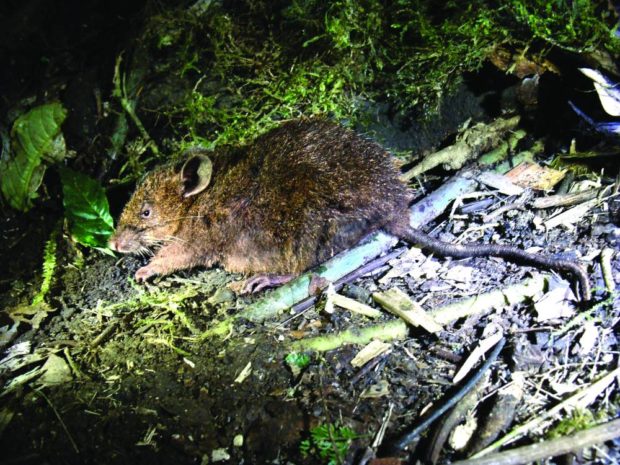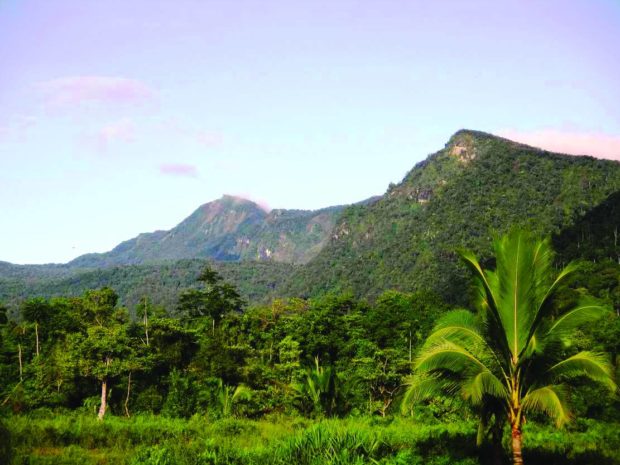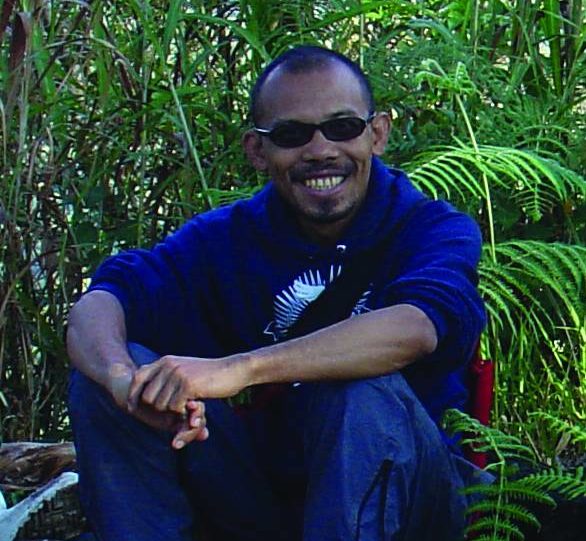Newly discovered mountain mouse honors late PH scientist’s work

BIODIVERSITY STOCK | The discovery of the long-nosed “shrew mouse” (left), named “Balete’s mouse” after the late Filipino mammalogist Danilo Balete, indicates the rich bioversity stock at Mt. Kampalili in Davao Oriental province. (Photo from the collection of Danilo Balete courtesy of Jayson Ibañez)
D AVAO CITY—Scientists have named a newly discovered long-nosed “shrew mouse” after a Filipino mammalogist who first discovered it in the forests of Mt. Kampalili in Davao Oriental province.
The shrew mouse, which has been revealed to be not just a new species, but a whole new genus, is seen to boost conservation works for the Philippine eagle, according to a statement from Chicago’s Field Museum of Natural History.
Scientists gave the new genus the scientific name, Baletys kampalili, which means “Balete’s mouse,” to honor the late biologist Danilo Balete, who, aside from discovering the mouse during his fieldwork in 2010, had been credited for his contribution to scientific knowledge about biological diversity in the Philippines.
“In the past several decades, we’ve learned just how incredibly important the mountains in the Philippines are in terms of being home to mammals that are found nowhere else, and a lot of that knowledge can be traced back to fieldwork led by Danny Balete,” said Larry Heaney, curator of mammals at Chicago’s Field Museum and senior author of the paper, describing the new mouse in the Journal of Mammalogy.
“Naming a new species after anyone is a big deal, a major honor given to people who make long-term, high-impact contributions to biodiversity science,” added Dakota Rowsey, first author of the study entitled, “A new genus and species of shrew-like mouse (Rodentia: Muridae) from a new center of endemism in eastern Mindanao, Philippines,” published on August 18 this year in the peer-reviewed journal. Aside from Heaney and Rowsey, Filipino scientists Mariano Roy M. Duya and Jayson C. Ibañez co-authored the study along with Sharon A. Jansa of the University of Minnesota and Eric A. Rickart of the Natural History Museum of Utah.
Article continues after this advertisement“Naming a new genus after someone is one of the highest honors biologists can bestow,” said Rowsey, the vertebrate collections manager at Arizona State University and research associate at the Field Museum.
Article continues after this advertisement
Mt. Kampalili in Davao Oriental province. (Photo from the collection of Danilo Balete courtesy of Jayson Ibañez)
First sighting
The “shrew mouse” was first sighted in 2010, when Balete joined the second field work of the expedition that started in 2007 to Mt. Kampalili as part of the collaboration between the Field Museum and the Philippine Eagle Foundation (PEF) to study what mammals lived alongside one of the largest and most critically endangered birds, the Philippine eagle.
While on Mt. Kampalili, Balete and his team discovered a dark brown mouse with small eyes and a long, tapering nose like a shrew, but different from anything he had ever seen in Mindanao because it looked more those he had seen on the island of Luzon.
“High up in the mountains, Danny was able to get cell phone service, so he sent me a text message right away, saying, ‘We just caught this animal that looks a lot like the ones from Luzon, and it shouldn’t be here,’” Heaney recalled. “So he immediately recognized that this was something really cool.”
He said three specimens of the new mouse were then shipped to the Field Museum for further analysis. The results confirmed Balete’s hunch.
When scientists discover something in the field, it often takes years for their work to be analyzed, written up and published, which was the case with the newly described “shrew mouse,” the statement said.
Despite Balete’s death in July 2017, his colleagues continued to study the specimens from his fieldwork. Rowsey, then a postdoctoral researcher with Heaney, led a DNA analysis of the “shrew mouse” and found that Balete was right: the rodent was different from any species known to science.
“That DNA study demonstrated that the new mouse was not related to the species up in the northern Philippines, but instead was related to species from Mindanao. It appears as though this is a remarkable case of what biologists call convergence—distantly related species that have independently evolved to resemble each other in ways that allow them to use habitats and resources in similar ways,” said Rowsey.
Piece of a puzzle
Aside from honoring Balete, scientists consider the new genus important because “it’s another puzzle piece in understanding the diversity of life in the Philippines.”
“Demonstrating that Mt. Kampalili is home to a mouse found nowhere else on earth may bolster conservation efforts by indigenous communities which would help the mouse’s neighbors, including the critically endangered Philippine eagles,” the statement said.
“It’s really important to show that when we protect one species, like the magnificent Philippine eagle, we protect not only our unique biological wealth but our cultural heritage as well,” said Jayson Ibañez, coauthor and director for research and conservation at PEF.
He said the Philippine eagle and “Balete’s mouse” were neighbors to the indigenous Mandaya group of Mt. Kampalili.
“Indigenous peoples get very excited whenever they learn that they share their homeland with a totally unique life form. And in this case, when we help protect Mt. Kampalili, we also protect the primary watershed, airsheds and biocultural sanctuaries for much of southeastern Mindanao, giving huge benefits to all the people who live here,” Ibañez said.
“With all of the threats from watershed destruction and climate change, we need all the help we can get,” he added.

INSPIRATION | The late biodiversity scientist Danilo Balete remains an inspiration to
many biological researchers in the Philippines. (Photo courtesy of the Field Museum of Natural History)
‘Bigger deal’
Animals (and plants and fungi and other organisms) were given scientific names based on what were their closest relatives, the Field Museum explained in the statement.
“Humans, for instance, are Homo sapiens. Sapiens is our species, and we’re part of the larger genus Homo, which includes our now-extinct closest relatives such as Neanderthals, Homo neanderthalensis. And since a genus is a higher-level group than a species, describing a whole new genus, like this mouse, is a bigger deal than finding a new species,” it said.
“New species of mammals are being discovered globally at a considerable clip, maybe 50 to 100 new species per year,” said Heaney. “Finding a brand-new genus, previously unknown to science like this one, that only happens at most a couple of times per year. In our 40 years of intensive study of Philippine mammals, this is one of nearly 50 new species, but just the fourth new genus we discovered.”
According to the statement, the mountains of the Philippines may not get as much attention as the Amazon Rainforest or the Great Barrier Reef but these are one of the most biologically diverse places on the planet.
“Inch for inch, these misty cloud forests are home to more unique species of mammals per square mile than anywhere else on earth. Finding these mammals, most of which are tiny and hard to spot, is difficult work for even the most seasoned scientists. But the late biologist Danilo Balete had a special knack for fieldwork,” it said.
Mentor
Scientists believe that the mountainous geography of the Philippines also contributed to its biodiversity.
“Its high mountains are cooler and much wetter than surrounding lowlands, and it’s difficult for small mammals to get from one mountain peak to the next. As a result, they tend to stay isolated on their own ‘sky islands,’ evolving separately from each other and forming new species. The taller and the bigger the mountain range, the more species of mammals will be living there that don’t live anywhere else in the world,” Heaney said.
Heaney, who has been studying the mammals of the Philippines in the last 40 years, first met Balete in the late 1980s when Balete just completed his BS in zoology at the University of the Philippines in Los Banos and was already making a name for himself with his love of nature and skill at fieldwork.
“I was establishing a research program, and asked around, ‘Who would be a really good, enthusiastic young person to take into the field?’ And several people immediately said, ‘Danny Balete.’ So I invited him to do some field work with me, and he did fantastically well,” Heaney recalled.
“He was just a superb field biologist. Danny could identify every plant, every frog, every bug, everything that you encountered, it was just astounding,” he added.
Balete and Heaney went on to work together for the next 25 years until Balete’s sudden death in July 2017 at the age of 57.
“Danny contributed hugely to scientific knowledge about biological diversity in the Philippines. His enjoyment of biodiversity was really infectious, making him a mentor and inspiration to a generation of researchers and conservationists,” said Mariano Roy Duya, assistant professor of biology at the University of the Philippines, and coauthor of the newly published study. “By the time of his death at far too young an age, he was already one of the most prominent biodiversity scientists working in the Philippines.”
His colleagues agreed that even after his death, Balete still continued to shape what scientists knew about Philippine mammals. “As we began picking up the pieces after his death, it became obvious to us that we had to name this new mouse after him, he deserves this,” Duya said.
RELATED STORIES
Snake named after national scientist and ex-DENR chief Alcala
Rare plant species named in honor of Philippine wildlife expert